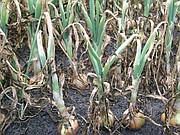Growing onions in the Basin has its pitfalls
Onion growers on both sides of the Columbia River deal with a lot of common problem areas. In times past, they have had difficulty finding solutions through local research that can bring relief from the issues plaguing their crops.
But a system is in place: the Columbia Basin Onion Research Committee provides the necessary vehicle to help ease their concerns.
“The Columbia Basin was the only major onion production region in the country that hadn’t gotten together formally to talk about research and funding for the many obstacles growers face,” said Tim Waters, Regional Vegetable Specialist and Franklin County Director at Washington State University Extension, who is the advisor to the committee. “So the committee was formed to find answers to problems they were dealing with.”
Although the committee was officially up and running last year, Waters said there are a lot of growers who have yet to take advantage of all there is to offer.
“We’ve had pretty good participation, but not all growers are participating yet and the idea of this thing is a collective thing that helps all growers, so we want more growers to participate in the process,” Waters said. “They all have common issues and we want to work on them, so it makes it better for everyone in the long run.”
The non-profit committee is composed of growers from different regions with different size operations who’ve reached out to their neighbors to find out problems they are having growing onions. The four board members are Larry Bauman from Connell, Lorin Grigg from Quincy, Michael Locati from Walla Walla, and Taryn Hartley from Prosser.
Waters said it’s difficult to address research questions without a funding mechanism in place. There are places researchers can apply for money for projects, but a lot of those entities require matching funding from growers to be able to get research funding. So the hope was that if growers could put collective dollars together and provide money to get projects going, researchers could go to the USDA or Washington State Department of Agriculture’s block grant program and apply for matching funding.
“The growers decided to impose a self-assessed rate of $5 per acre that goes into a committee fund,” Waters said. “The committee then sends out a request for proposals to researchers in the Columbia Basin to let them know the problems growers are facing and to ask them to submit them based on their priority areas. The committee then reviews the proposals to decide which ones to fund.”
Waters serves as the advisor to the committee. His role is to make growers aware of specific issues and help them find the answers to their questions concerning research proposes being submitted.
“Working for WSU Extension, I get calls from growers all across the Columbia Basin with varying onion issues. I am an entomologist by trade, so I can help them understand the research projects a little bit better.”
Many of the issues growers face, Waters said, are problems with the Iris yellow spot virus, downy mildew and internal dry scale.
“Growers in the north central Columbia Basin have dealt extensively with the Iris yellow spot virus. Onion thrips eating on the plant creates a lot of damage that results in a vector virus. Another issue that has come up recently is downy mildew, a fungal disease caused by a pathogen that can be attributed to the varying weather patterns the last few years. Growers are also dealing with internal dry scale that causes onions to rot from the inside. We still don’t understand what creates that problem, but research is being done on it.”
As one might imagine, these issues, if not dealt with properly, can result in significant yield loss, which translates into a whole lot of lost income.
“If the thrips feeding on the plants go untreated, it can reduce yield by 35 to 40 percent. A virus on the plant diminishes yield even further, so it’s important growers know which insecticide to apply. We don’t have solid numbers on the downy mildew because it’s reactively a new problem for us here,” Water said. “The internal dry scale issue was a huge problem in 2014 and 2015. Because it causes onions to rot from the inside out, the issue often goes undetected — you typically don’t find it until you cut one open. Entire fields full of onions with internal dry scale are of no value. Onions in storage units have to be thrown out. It’s a huge loss to the growers.”
Waters said he has “boots on the ground” so if he sees a problem growers are having he can help identify the issue and find available solutions. And that’s where the committee comes into play.
Growers with questions or suggestions for the committee are asked to contact Sheri Nolan at (509) 585-5460.





